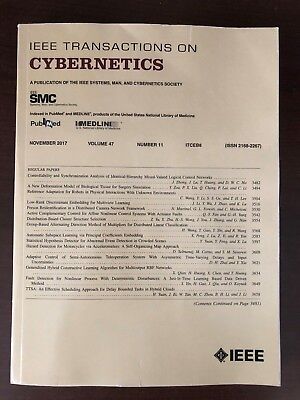非线性系统的实际时间同步命令滤波反步控制。
IF 10.5
1区 计算机科学
Q1 AUTOMATION & CONTROL SYSTEMS
引用次数: 0
摘要
本文主要研究非线性和输入饱和不匹配的多输入多输出(MIMO)系统的实际时间同步跟踪控制问题。与现有的控制方法不同,提出了一种实际时间同步的命令滤波反步控制方案。该框架将改进的命令滤波器与采用范数归一化符号函数设计的控制信号相结合,既保留了CFB控制方法的优点,又保证了时间同步收敛的特性。具体来说,“复杂性爆炸”现象和滤波误差的影响同时得到了解决,尽管高阶系统中存在不可匹配的非线性,但跟踪误差的所有分量都可以在有限时间内实现几乎同步收敛到原点的小邻域。此外,新的辅助系统递归嵌入到时间同步循环流化床设计的每一步,以抵消输入饱和的影响。严格的理论分析和对比仿真验证了所提控制方案的合理性、有效性和优越性。本文章由计算机程序翻译,如有差异,请以英文原文为准。
Practically Time-Synchronized Command Filtered Backstepping Control of Nonlinear Systems.
This article concentrates on the problem of practically time-synchronized tracking control for multi-input multi-output (MIMO) systems with unmatched nonlinearities and input saturations. Different from the existing approaches, a practically time-synchronized command filtered backstepping (CFB) control scheme is proposed. By integrating modified command filters and control signals designed with norm-normalized sign functions, the newly developed framework not only retains the advantages of the CFB control approach but also guarantees the property of time-synchronized convergence. Specifically, the "explosion of complexity" phenomenon and the influence of filtering errors are simultaneously addressed, and all components of the tracking error can achieve practically synchronous convergence to a small neighborhood of the origin in a finite time, despite the presence of unmatched nonlinearities in high-order systems. Furthermore, novel auxiliary systems are recursively embedded into each step of the time-synchronized CFB design to counteract the effect of input saturation. Rigorous theoretical analyses and comparative simulations demonstrate the rationality, effectiveness, and superiority of the proposed control scheme.
求助全文
通过发布文献求助,成功后即可免费获取论文全文。
去求助
来源期刊

IEEE Transactions on Cybernetics
COMPUTER SCIENCE, ARTIFICIAL INTELLIGENCE-COMPUTER SCIENCE, CYBERNETICS
CiteScore
25.40
自引率
11.00%
发文量
1869
期刊介绍:
The scope of the IEEE Transactions on Cybernetics includes computational approaches to the field of cybernetics. Specifically, the transactions welcomes papers on communication and control across machines or machine, human, and organizations. The scope includes such areas as computational intelligence, computer vision, neural networks, genetic algorithms, machine learning, fuzzy systems, cognitive systems, decision making, and robotics, to the extent that they contribute to the theme of cybernetics or demonstrate an application of cybernetics principles.
 求助内容:
求助内容: 应助结果提醒方式:
应助结果提醒方式:


